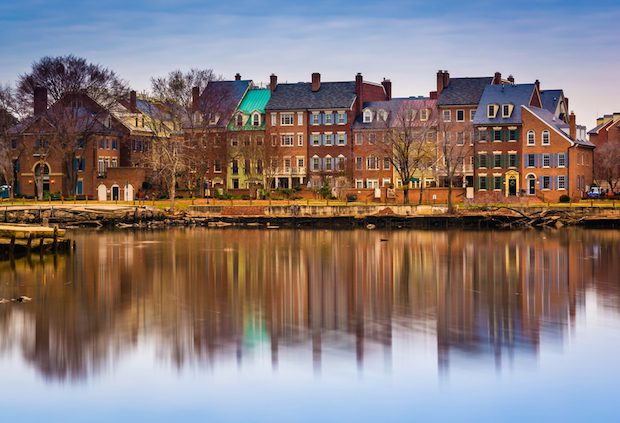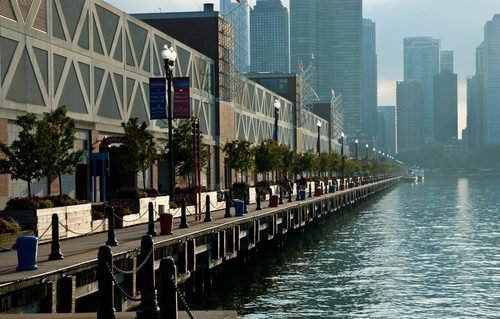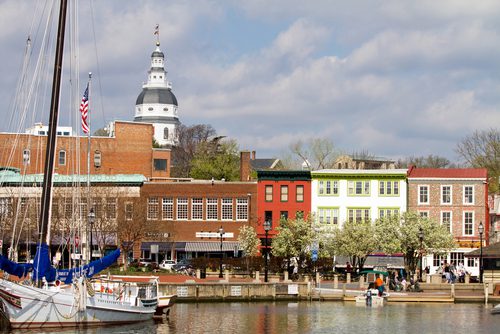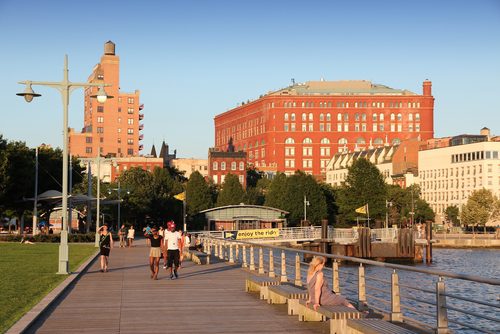What to Do With Waterfronts?

Many city waterfronts used to be seedy industrial spaces: Dickensian areas once characterized by water trade and commerce, marked occasionally by squalor or disrepute. But as cities have changed, grown, and gentrified, our waterfronts are changing too.
An October 3 piece in The Atlantic described one of these new waterfront redevelopment projects, currently underway in Allentown, Pennsylvania:
Development of part of the riverfront portion started in July, when crews began demolishing the long-abandoned Lehigh Structural Steel plant that, until it closed in 1992, had operated along the banks of the river for more than 70 years. … Other buildings being demolished in the former industrial area to make way for the Waterfront development include warehouses for a tire company and a scrap-metal yard. The plans for the $325 million Waterfront development are ambitious, just like the other efforts to revitalize the core of this long-beaten-down city. By the time the Waterfront is completed in eight to 10 years, the 26-acre mixed-use site will have 610,000 square feet of office space, a mix of upscale dining and retail, and 172 luxury apartments. There’ll be a half-mile “river walk,” more than a mile of walking and running paths, and two large open-space plazas, all designed to provide unobstructed water views and access to the river itself. … It says something about how hungry people in this community are for the kind of “live-work-play” area this development promises that the planning stage was free of conflict and controversy.
There are significant similarities between the changes described here, and Alexandria, Virginia’s waterfront development—a project I wrote about in an article earlier this year: the continuous “river walk,” the large open-space plazas, the mixed-use office space, dining, retail, and luxury apartments (though in Alexandria’s case, it will be a boutique hotel). The only significant difference between the two towns, interestingly, is the community support—Alexandria’s waterfront projects has been anything but “free of conflict and controversy.” Alexandria is a historical colonial town currently policed by a passionate group of conscientious citizens who are wary of changes that could have deleterious effects on their historic homes and streets. And while Allentown is also a historical town, its status as “long-beaten-down” (in Tierney’s words) contrasts significantly with the pristine and wealthy neighborhoods that flock Alexandria’s King Street.
Nonetheless: changes, even good changes, have consequences. Waterfront projects—be they in wealthy, well-kept communities or in run-down spaces—need a sense of scale and structure in order to foster beneficial growth.
When I wrote about Alexandria’s waterfront project, New Urbanists Peter Katz and Philip Bess both offered a wealth of ideas and tips for excellent, human-scale waterfront development. There were a lot of things we discussed that I simply didn’t have room for in my story—so here are a few “bonus” comments from the two men. They explained five specific ways to help make a waterfront a good New Urbanist space:
Build for locals, not tourists.
Philip Bess, a Notre Dame professor and architect, emphasized the importance of building for the local community. He looked to the city of Chicago as precedent: “Part of its tradition, dating back to the early part of 20th century, was that the lake front was a public amenity,” he said.

Almost the entire 25 miles of lakefront is dotted with public parks, and holds a continuous recreational path. Though there are some buildings throughout the space, the city historically made sure that the waterfront was open and inviting, for residents to enjoy.
“It’s not a matter of not wanting tourists on the lakefront—it’s a matter of making sure that, primarily, Chicago is for Chicagoans,” Bess said. And it’s worth noting that a space locals enjoy will also be enjoyable for tourists—while it often doesn’t work the other way around.
Keep a structure and a frame.
Though waterfronts are beautiful, they are “one-sided spaces.” And this, according to Peter Katz, founding executive director of the Congress for the New Urbanism, can be a problem. Whereas city squares and centers have “neighborhood fabric on all sides,” activity on a waterfront comes from only one direction. Thus, he said, “bringing the activity right up to the water’s edge is kind of an unnatural act”—and planners need to adapt and build accordingly. Since waterfront activity only comes from one side, “it really becomes a special trip—usually at a higher price, [something] not in your daily plan.”

This means that waterfronts need both a sense of scale, and a framework of sorts. Katz pointed to the city of Annapolis, Maryland, as an example of an excellently designed waterfront (picture on the right): it has a continuous promenade along the water’s edge, flocked by narrow streets (which prevent heavy, fast-moving traffic). It also features a frame of two to four-story buildings, with stately trees and the capitol building in the background. What this achieves, according to Katz, is a frame of reference, in what would otherwise be a “big open space” with no “sense of containment”—creating a sense of lostness. “You could be in Wyoming, for all you know,” he said. “It’s the buildings that shape the space, and on the waterfront, give it definition and an edge.”
Create a boardwalk.
Katz and Bess both emphasized the importance of a continuous promenade (or boardwalk)—it adds to a space’s usability and popularity. It opens up the space to regular foot or bike traffic, which keeps community involvement at a high, and also makes sure the space is regularly policed by community members.

Katz referenced New York City’s Hudson riverfront as an example of a well-done riverfront: “they’ve pieced it together and it works pretty well.” The space is used frequently by runners, walkers, tourists, moms pushing strollers, and others. It offers excellent views of the city and Hudson, the Statue of Liberty and other key points. A boardwalk can stitch together riverfront elements like a well-placed thread, weaving in and out of various spaces while maintaining a sense of cohesion. It makes a space feel alive, and well-tended.
Don’t over-plan open spaces.
Though Katz, like Bess, believes that parks and plazas are important for local use, he also believes that such spaces can often be over-done—and too much public park space on a riverfront can have unintended consequences. “When you bring too much activity to the water’s edge and over-program it,” Katz warns, “you’ll find that when the project’s new and exciting, it will function for a few years” but before long “waterfronts become very tired. …Wherever you go to cool waterfront projects 10 years after they were created, they’re under-occupied. It’s a result of programming a level of activity and commerce that can’t be maintained.”
Parks and plazas need a sense of scale: an appropriate amount of smallness, that enables the space to feel busy and exciting, even when it isn’t filled to capacity. This will prevent a feeling of deadness at under-occupied times (which can often lead to greater amounts of crime). Planning small may seem counterintuitive to planners who hope for a thriving, bustling space—but it’s one of the key ways to keep parks and waterfronts vibrant for locals and tourists.
Keep commerce open.
Both Bess and Katz noted that waterfronts have precedents as working spaces: places of commerce and economic activity. For decades, Alexandria’s edge was an “interface between water and land-born commerce,” Katz says. Just because the town has become a more “exclusive address” in the last 30 years or so, doesn’t mean that we should entirely forget this historical precedent—its history and historical purpose.
This could mean including historical artifacts, mimicking the structure and style of old buildings or piers in updated designs. But it could also mean continuing some of the practices and purposes that have always driven the waterfront—keeping commerce, and the presence of commercial buildings, alive.
“The waterfronts that have been shaped through commerce are always unique, distinctive, and wonderful in ways that more recent waterfronts aren’t,” Katz said. He encouraged places like Alexandria and Allentown not to give too much space to parks and big public areas, but rather to allow space for cafes, shops, and residential buildings or hotels. The design, of course, should be cohesive with the landscape and its traditions: both in block structure, and in architectural design. The presence of these buildings will help pay for the space and its upkeep; but it’s also about keeping that thriving, busy, bustling waterfront feeling alive.
♦♦♦
Why are waterfronts important? Tierney calls them “a treasured asset that can be leveraged for the good of the community.” Both Bess and Katz’s comments spoke to their beauty, their ability to knit together a community. As someone who has spent a lot of time traversing Alexandria’s waterfront, with its various trails and walking paths, I can speak to the ability a waterfront has to become part of your everyday life: it’s the place where you take picnics or watch outdoor movies, go for Saturday-morning strolls or eat your Friday-evening ice cream. It’s a place that develops “regulars”: locals who run at 6:30 a.m. or walk their dog at 7:00 p.m., read on a bench over lunch breaks or play sand volleyball on Wednesday night.
All of these things become part of a community’s traditions. They help knit people together, create a sense of neighborliness, cultivate civic ownership and pride. A waterfront can offer many amenities, and redevelopment projects offer an excellent opportunity to curate and cultivate those services. But always, we must be mindful of how we plan and build—to make sure we cultivate spaces that are human-scale and beautiful, spaces that will be treasured and enjoyed for decades to come.
This post was supported by a grant from the Richard H. Driehaus Foundation.
Comments